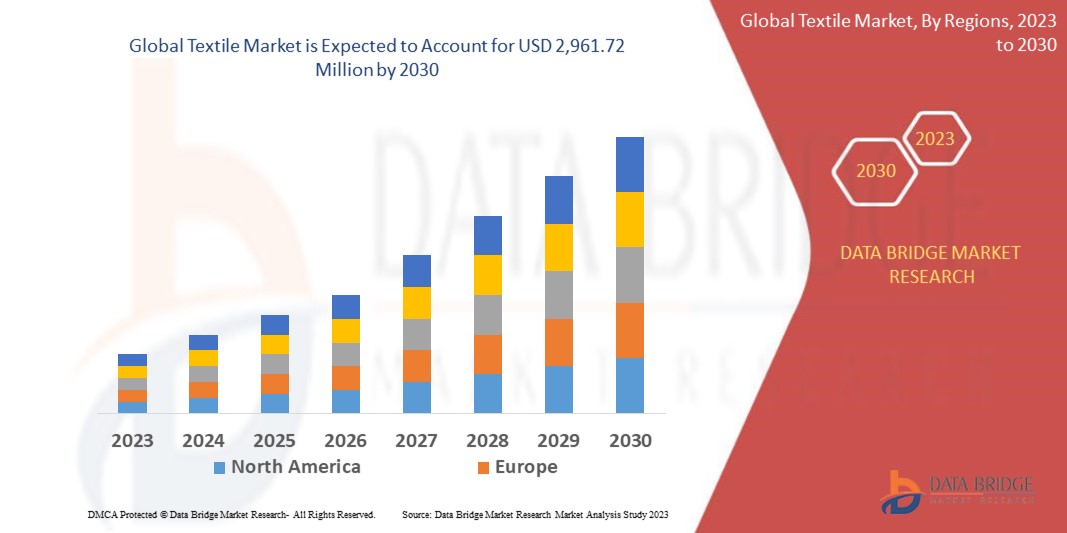Global Textile Market
Tamanho do mercado em biliões de dólares
CAGR :
% 
 USD
1,122.00 Million
USD
2,961.72 Million
2022
2030
USD
1,122.00 Million
USD
2,961.72 Million
2022
2030
| 2023 –2030 | |
| USD 1,122.00 Million | |
| USD 2,961.72 Million | |
|
|
|
|
Global Textile Market, By Raw Material (Cotton, Chemical, Wool, Silk, Others), Product (Natural Fibers, Polyesters, Nylon, Others), Application (Household, Technical, Fashion & Clothing, Others), Process Type (Woven, Non-Woven) – Industry Trends and Forecast to 2030
Textile Market Analysis and Size
The textile can be defined as a type of cloth or woven fabric produced by spinning raw fibers into long and twisted lengths. It can also be defined as any material made up of interlacing fibers, including carpet, shirts, and others.
Data Bridge Market Research analyses that the Textile market which was USD 1,122.00 million in 2022, would rocket up to USD 2,961.72 million by 2030, and is expected to undergo a CAGR of 12.90% during the forecast period. The rising use of textiles across key end users like healthcare, defense, automobile, and others is contributing to the market growth. In addition to the insights on market scenarios such as market value, growth rate, segmentation, geographical coverage, and major players, the market reports curated by the Data Bridge Market Research also include in-depth expert analysis, geographically represented company-wise production and capacity, network layouts of distributors and partners, detailed and updated price trend analysis and deficit analysis of supply chain and demand.
Textile Market Scope and Segmentation
|
Report Metric |
Details |
|
Forecast Period |
2023 to 2030 |
|
Base Year |
2022 |
|
Historic Years |
2021 (Customizable to 2015-2020) |
|
Quantitative Units |
Revenue in USD Million, Volumes in Units, Pricing in USD |
|
Segments Covered |
Raw Material (Cotton, Chemical, Wool, Silk, Others), Product (Natural Fibers, Polyesters,Nylon, Others), Application (Household, Technical, Fashion & Clothing, Others), Process Type (Woven, Non-Woven) |
|
Countries Covered |
U.S., Canada, Mexico, Brazil, Argentina, Rest of South America, Germany, France, Italy, U.K., Belgium, Spain, Russia, Turkey, Netherlands, Switzerland, Rest of Europe, Japan, China, India, South Korea, Australia, Singapore, Malaysia, Thailand, Indonesia, Philippines, Rest of Asia-Pacific, U.A.E, Saudi Arabia, Egypt, South Africa, Israel, Rest of Middle East and Africa. |
|
Market Players Covered |
Lu Thai Textile Co., Limited (China), REDA GROUP (France), Paramount textiles (India), Paulo de Oliveira, SA (Portugal), Nike, Inc. (US), Adidas AG (Germany), Aditya Birla Management Corporation Pvt. Ltd. (India), Levi Strauss & Co. (US), Arvind Limited (India), Bombay Rayon Fashions Limited (India), Fabindia (India), Cotton Corporation of India (India), Dorothy Perkins (UK), Bruno Banani (Germany), CONE DENIM LLC (US), Canterbury Antex Knitting Mills (US), Coville (US), Loyal Textile (India), Reliance Industries Limited (India), YI CHUN TEXTILE LTD (Taiwan), Shahlon Group (India), Weiqiao Textile Company Limited (China), China Textiles (Shenzhen) Co.,Ltd (China), and HuaFang Group (China). |
|
Market Opportunities |
|
Market Definition
The term Textile refers to a type of cloth or woven fabric produced by spinning raw fibers into long and twisted lengths. It can also be defined as any material made up of interlacing fibers, including carpet, shirts, and others.
Textile Market Dynamics
Drivers
- Increasing textile applications in various industries.
The widespread usage of textiles across key end use industries, like healthcare, defense, automobile, and others, is contributing to the market growth. The growing fashion and clothing industry in emerging economies, owing to the rising disposable income and increasing population, is likely to propel the demand for textiles.
- Rapidly growing consumer preference towards sustainable products.
The rapidly growing consumer preference towards sustainable products is forcing major textile companies to focus on restructuring their business and investing in manufacturing practices that target sustainable products. There has been an increasing trend in the use of smart textiles in the market that use optical fibers, metals, and various conductive polymers to interact with the environment.
Opportunities
The rising application will create growth opportunities for the textile market and increase its adoption in several markets. Design innovation, along with the development of new upholstery products, will further bring various opportunities for the growth of the textile market for the market players in the forecast period of 2023 to 2030.
Restraints/Challenges
On the other hand, the pandemic has acted as a restraint to the global market growth for textiles which will further hinder the growth potential of the textile market. Also, the adoption of recycling techniques is projected to challenge the market in the forecast period of 2023-2030.
This Textile market report provides details of new recent developments, trade regulations, import-export analysis, production analysis, value chain optimization, market share, the impact of domestic and localized market players, analyses opportunities in terms of emerging revenue pockets, changes in market regulations, strategic market growth analysis, market size, category market growths, application niches and dominance, product approvals, product launches, geographic expansions, technological innovations in the market. To gain more info on the Textile market contact Data Bridge Market Research for an Analyst Brief. Our team will help you make an informed market decision to achieve market growth.
Recent Developments
- In Feb 2021, The Indian Government announced the setting up seven mega textile parks in the next three years. The government has also decided to rationalize the duties on raw material inputs to manmade textiles by reducing the customs duty rate on caprolactam, nylon chips, and nylon fiber and yarn to 5 %
- In Feb 2021, Paraguay’s Ministry of Industry and Commerce announced that it would invest USD 1.1 million in the manufacturing sector, mainly benefiting the clothing, textiles, and footwear industries, among other areas related to assembly operations.
Global Textile Market Scope
The Textile market is segmented on the basis of raw material, product, application, and process type. The growth amongst these segments will help you analyse meagre growth segments in the industries and provide the users with a valuable market overview and market insights to help them make strategic decisions for identifying core market applications.
Raw Material
- Cotton
- Chemical
- Wool
- Silk
- Others
Product
- Natural
- Fibers
- Polyester
- Nylon
- Others
Application
- Household
- Technical
- Fashion & Clothing
- Others
Process Type
- Woven
- Non-Woven
Global Textile Market Regional Analysis/Insights
The textile market is analysed and market size insights and trends are provided by raw material, product, application, and process type, as referenced above.
The countries covered in the Textile market report are U.S., Canada, Mexico, Brazil, Argentina, Rest of South America, Germany, France, Italy, U.K., Belgium, Spain, Russia, Turkey, Netherlands, Switzerland, Rest of Europe, Japan, China, India, South Korea, Australia, Singapore, Malaysia, Thailand, Indonesia, Philippines, Rest of Asia-Pacific, U.A.E, Saudi Arabia, Egypt, South Africa, Israel, Rest of Middle East and Africa
Asia-Pacific is expected to dominate the textile market due to the rising demand for apparel along with the high production of cotton and easy availability of labor at low cost. Europe region is expected to hold the largest growth rate due to the imposition of stringent regulations on product quality.
Asia-Pacific is expected to witness significant growth during the forecast period of 2023 to 2030 because of the rising demand for apparel in this region.
The country section of the report also provides individual market impacting factors and changes in regulation in the market domestically that impacts the current and future trends of the market. Data points like down-stream and upstream value chain analysis, technical trends, and porter's five forces analysis, case studies are some of the pointers used to forecast the market scenario for individual countries. Also, the presence and availability of global brands and their challenges faced due to large or scarce competition from local and domestic brands, the impact of domestic tariffs, and trade routes are considered while providing forecast analysis of the country data.
Competitive Landscape and Textile Market Share Analysis
The textile market competitive landscape provides details by competitors. Details included are company overview, company financials, revenue generated, market potential, investment in research and development, new market initiatives, global presence, production sites and facilities, production capacities, company strengths and weaknesses, product launch, product width, and breadth, application dominance. The above data points provided are only related to the companies' focus related to the textile market.
Some of the major players operating in the textile market are:
- Lu Thai Textile Co. Limited (China)
- REDA GROUP (France)
- Paramount textiles (India)
- Paulo de Oliveira
- SA (Portugal)
- Nike Inc. (US)
- Adidas AG (Germany)
- Aditya Birla Management Corporation Pvt. Ltd. (India)
- Levi Strauss & Co. (US)
- Arvind Limited (India)
- Bombay Rayon Fashions Limited (India)
- Fabindia (India)
- Cotton Corporation of India (India)
- Dorothy Perkins (UK)
- Bruno Banani (Germany)
- CONE DENIM LLC (US)
- Canterbury Antex Knitting Mills (US)
- Coville (US)
- Loyal Textile (India)
- Reliance Industries Limited (India)
- YI CHUN TEXTILE LTD (Taiwan)
- Shahlon Group (India)
- Weiqiao Textile Company Limited (China)
- China Textiles (Shenzhen) Co.Ltd (China)
- HuaFang Group (China).
SKU-
Obtenha acesso online ao relatório sobre a primeira nuvem de inteligência de mercado do mundo
- Painel interativo de análise de dados
- Painel de análise da empresa para oportunidades de elevado potencial de crescimento
- Acesso de analista de pesquisa para personalização e customização. consultas
- Análise da concorrência com painel interativo
- Últimas notícias, atualizações e atualizações Análise de tendências
- Aproveite o poder da análise de benchmark para um rastreio abrangente da concorrência
Metodologia de Investigação
A recolha de dados e a análise do ano base são feitas através de módulos de recolha de dados com amostras grandes. A etapa inclui a obtenção de informações de mercado ou dados relacionados através de diversas fontes e estratégias. Inclui examinar e planear antecipadamente todos os dados adquiridos no passado. Da mesma forma, envolve o exame de inconsistências de informação observadas em diferentes fontes de informação. Os dados de mercado são analisados e estimados utilizando modelos estatísticos e coerentes de mercado. Além disso, a análise da quota de mercado e a análise das principais tendências são os principais fatores de sucesso no relatório de mercado. Para saber mais, solicite uma chamada de analista ou abra a sua consulta.
A principal metodologia de investigação utilizada pela equipa de investigação do DBMR é a triangulação de dados que envolve a mineração de dados, a análise do impacto das variáveis de dados no mercado e a validação primária (especialista do setor). Os modelos de dados incluem grelha de posicionamento de fornecedores, análise da linha de tempo do mercado, visão geral e guia de mercado, grelha de posicionamento da empresa, análise de patentes, análise de preços, análise da quota de mercado da empresa, normas de medição, análise global versus regional e de participação dos fornecedores. Para saber mais sobre a metodologia de investigação, faça uma consulta para falar com os nossos especialistas do setor.
Personalização disponível
A Data Bridge Market Research é líder em investigação formativa avançada. Orgulhamo-nos de servir os nossos clientes novos e existentes com dados e análises que correspondem e atendem aos seus objetivos. O relatório pode ser personalizado para incluir análise de tendências de preços de marcas-alvo, compreensão do mercado para países adicionais (solicite a lista de países), dados de resultados de ensaios clínicos, revisão de literatura, mercado remodelado e análise de base de produtos . A análise de mercado dos concorrentes-alvo pode ser analisada desde análises baseadas em tecnologia até estratégias de carteira de mercado. Podemos adicionar quantos concorrentes necessitar de dados no formato e estilo de dados que procura. A nossa equipa de analistas também pode fornecer dados em tabelas dinâmicas de ficheiros Excel em bruto (livro de factos) ou pode ajudá-lo a criar apresentações a partir dos conjuntos de dados disponíveis no relatório.















